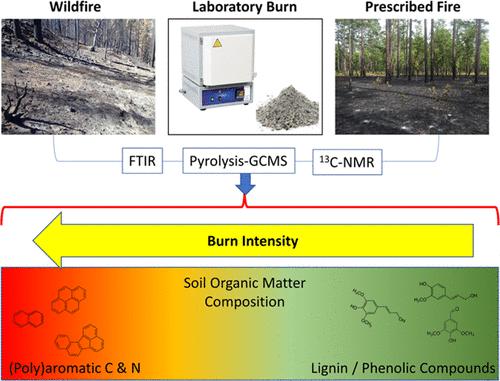当前位置:
X-MOL 学术
›
Environ. Sci. Technol.
›
论文详情
Our official English website, www.x-mol.net, welcomes your
feedback! (Note: you will need to create a separate account there.)
Burn Intensity Drives the Alteration of Phenolic Lignin to (Poly) Aromatic Hydrocarbons as Revealed by Pyrolysis Gas Chromatography–Mass Spectrometry (Py-GC/MS)
Environmental Science & Technology ( IF 10.8 ) Pub Date : 2022-08-10 , DOI: 10.1021/acs.est.2c00426 Huan Chen 1 , Jun-Jian Wang 2, 3 , Pei-Jia Ku 4 , Martin Tsz-Ki Tsui 5 , Rebecca B Abney 6 , Asmeret Asefaw Berhe 7 , Qiang Zhang 2, 3 , Sarah D Burton 8 , Randy A Dahlgren 9 , Alex T Chow 1
Environmental Science & Technology ( IF 10.8 ) Pub Date : 2022-08-10 , DOI: 10.1021/acs.est.2c00426 Huan Chen 1 , Jun-Jian Wang 2, 3 , Pei-Jia Ku 4 , Martin Tsz-Ki Tsui 5 , Rebecca B Abney 6 , Asmeret Asefaw Berhe 7 , Qiang Zhang 2, 3 , Sarah D Burton 8 , Randy A Dahlgren 9 , Alex T Chow 1
Affiliation

|
High-intensity wildfires alter the chemical composition of organic matter, which is expected to be distinctly different from low-intensity prescribed fires. Herein, we used pyrolysis gas chromatography/mass spectrometry (Py-GC/MS), in conjunction with solid-state 13C nuclear magnetic resonance (NMR) and Fourier transform infrared (FT-IR) spectroscopy, to assess chemical alterations from three wildfires and a long-term frequent prescribed fire site. Our results showed that black ash formed under moderate intensity burns contained less aromatic (ArH), polyaromatic hydrocarbon (PAH), and nitrogen-containing compounds (Ntg) but more lignin (LgC) and phenol compounds (PhC), compared to white ash formed under high intensity burns. Both 13C NMR and FT-IR confirmed a higher relative percentage of carboxyl carbon in white ash, indicating the potential for higher water solubility and more mobile carbon, relative to black ash. Compared to wildfires, ash from low-intensity prescribed fire contained less ArH, PAH, and Ntg and more LgC and PhC. Controlled laboratory burning trials indicated that organic matter alteration was sensitive to the burn temperature, but not related to the fuel type (pine vs fir) nor oxygen absence/presence at high burn temperatures. This study concludes that higher burn temperatures resulted in higher (poly)aromatic carbon/nitrogen and lower lignin/phenol compounds.
中文翻译:

热解气相色谱-质谱 (Py-GC/MS) 揭示燃烧强度推动酚类木质素向(多)芳香烃的转变
高强度野火改变了有机物的化学成分,预计这与低强度规定的火灾明显不同。在这里,我们使用热解气相色谱/质谱 (Py-GC/MS) 结合固态13 C 核磁共振 (NMR) 和傅里叶变换红外 (FT-IR) 光谱来评估三场野火的化学变化和一个长期频繁的规定火灾地点。我们的研究结果表明,与形成的白灰相比,在中等强度燃烧下形成的黑灰含有较少的芳香族 (ArH)、多环芳烃 (PAH) 和含氮化合物 (Ntg),但含有较多的木质素 (LgC) 和酚类化合物 (PhC)在高强度烧伤下。两个13C NMR 和 FT-IR 证实了白灰中羧基碳的相对百分比较高,表明相对于黑灰,具有更高水溶性和更多移动碳的潜力。与野火相比,低强度规定火灾产生的灰烬含有较少的 ArH、PAH 和 Ntg,而含有较多的 LgC 和 PhC。受控的实验室燃烧试验表明,有机物的变化对燃烧温度很敏感,但与燃料类型(松树与冷杉)无关,也与高燃烧温度下的氧气缺乏/存在无关。该研究得出结论,较高的燃烧温度导致较高的(多)芳香族碳/氮和较低的木质素/酚类化合物。
更新日期:2022-08-10
中文翻译:

热解气相色谱-质谱 (Py-GC/MS) 揭示燃烧强度推动酚类木质素向(多)芳香烃的转变
高强度野火改变了有机物的化学成分,预计这与低强度规定的火灾明显不同。在这里,我们使用热解气相色谱/质谱 (Py-GC/MS) 结合固态13 C 核磁共振 (NMR) 和傅里叶变换红外 (FT-IR) 光谱来评估三场野火的化学变化和一个长期频繁的规定火灾地点。我们的研究结果表明,与形成的白灰相比,在中等强度燃烧下形成的黑灰含有较少的芳香族 (ArH)、多环芳烃 (PAH) 和含氮化合物 (Ntg),但含有较多的木质素 (LgC) 和酚类化合物 (PhC)在高强度烧伤下。两个13C NMR 和 FT-IR 证实了白灰中羧基碳的相对百分比较高,表明相对于黑灰,具有更高水溶性和更多移动碳的潜力。与野火相比,低强度规定火灾产生的灰烬含有较少的 ArH、PAH 和 Ntg,而含有较多的 LgC 和 PhC。受控的实验室燃烧试验表明,有机物的变化对燃烧温度很敏感,但与燃料类型(松树与冷杉)无关,也与高燃烧温度下的氧气缺乏/存在无关。该研究得出结论,较高的燃烧温度导致较高的(多)芳香族碳/氮和较低的木质素/酚类化合物。











































 京公网安备 11010802027423号
京公网安备 11010802027423号